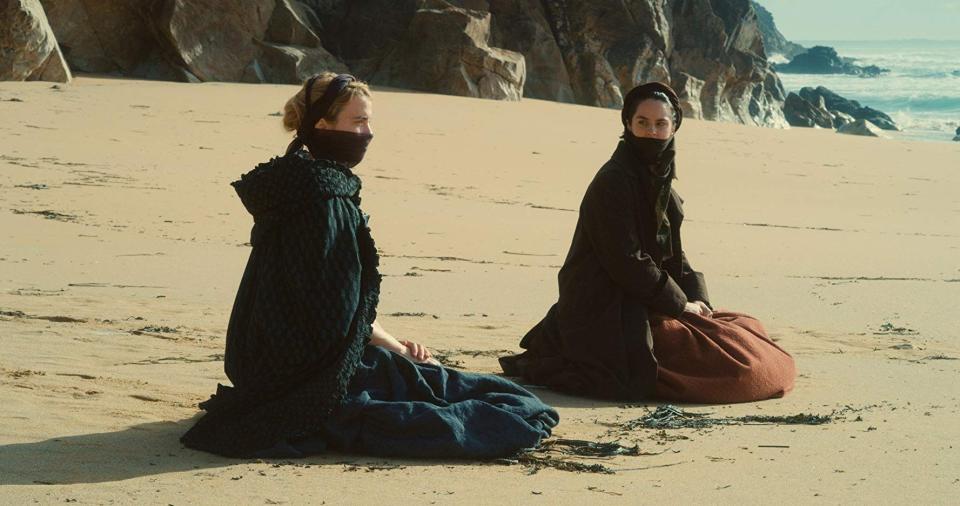Does Wearing a Mask Make You Look Hot?
The face mask has been established as a pandemic essential, the most politicized accessory this year, and a vehicle for expressing personal style. But there is yet another facet of this ubiquitous rectangular fabric, midway in size between table napkin and thong, that invites a closer look and a serious investigation: Does it make you look hot?
On social media, some people have mused, “Is it just me, or is everyone more attractive with a face mask on?” while others have outright declared, “Everyone is hotter in a face mask.” Paparazzi photos of Chris Pine wearing an N95 mask and conspicuously toting a bag of books went viral, leading BuzzFeed to publish the post “Chris Pine Buying Books and Wearing a Mask Is Literally the Hottest Celeb Pic of 2020” (and leading me to have an even harder time telling the Hollywood Chrises apart). In a Vice article titled “Not the Point, but We All Look Hot in Masks,” writer Katie Way observed that “the right mask makes its wearer look…good. Like, very good.… We’re wearing them because it’s good for us and for other people. But we’re not doing ourselves any favors by dancing around the fact that they also make us look hot.”
Yes, all these impure mask thoughts could just be the result of months of pent-up quarantine horniness. But they also might be onto something.
In seeking out some evidence in the theory’s favor, I called up Vanessa Brown, a senior lecturer in design and culture at Nottingham Trent University in the U.K., who has written about the effect that sunglasses have on increasing perceived attractiveness. Would the same principle apply to face masks, even if the bottom half of the face is covered instead?
“There's definitely something about the replacement of something fleshy and vulnerable [i.e., your face] with something that's engineered and machined and perfect,” Brown told me. “If you think of something like a classic suit, it does something similar to the male body.”
Risk, too, is a factor. Brown cited classic cultural images of outlaws in bandanas, or motorcyclists covering their faces to keep away dust and grit. “It suggests that you're engaged in some sort of slightly risky activity—which, obviously, just going to the corner shop has become,” she said. “All kinds of garments that signify exposure to risk have had quite a long-standing relationship with notions of coolness and therefore attractiveness of a certain kind.”
Another Western historical precedent Brown mentioned is the visard, a black velvet mask worn by ladies in 18th-century England. The visard, which looks like the earliest iteration of a gimp mask, was intended to allow women to go on strolls alone in public parks and still maintain their respectability, but, Brown said, “it actually encouraged quite sort of loose behavior, morally speaking. Women would wear these things, and then they would go and jolly around the parks trying to attract lovers.”
Most crucial is the element of mystery conjured up by the face mask. “It’s a long-standing supposition that if you cover something up, you create a sense of desire and anticipation to see what's beneath it,” Brown explained. “Where people cover the face but the eyes are visible, it's quite attractive because you're drawn in to that potential intimacy because the eyes are there, but you're also made aware of the fact that a lot of other things are being withheld from you.”

And now some bad news (or good news for the sex-negative among us): A 2016 study published in Japanese Psychological Research directly refutes the idea that face masks make people look more attractive. Researchers Yuki Miyazaki and Jun‐Ichiro Kawahara, inspired by some Japanese women who wear sanitary face masks when not wearing makeup, found that “perceived facial attractiveness was decreased in general by wearing a sanitary mask.” However, one of the main reasons was that people perceived the mask wearers to be unhealthy—an impression that may be changed in the midst of a global pandemic, when mask-wearing is either strongly encouraged or required for everyone.
In fact, a study from earlier this year, published in Scientific Reports, found that people judged incomplete faces in photographs to be more attractive than entirely visible faces. Lead researcher Diana Orghian told me in an email that “occluded faces are perceived as more attractive. We believe people fill in the missing parts with positive expectations or details.” Think of it like this: For all that stranger standing six feet away in the canned-bean aisle knows, you could be hiding a preposterously lush Tom Selleck mustache or Tom Hardy lips underneath that mask. And, if all goes well, they’ll get a look sometime in 2021.
We all need to wear masks—so here's a running list of designers producing them.
Originally Appeared on GQ


